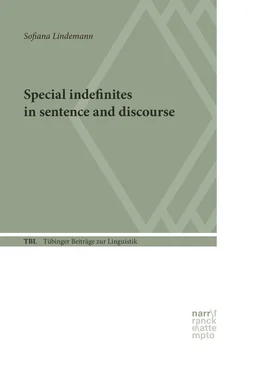This Chapter is structured as follows: In the first Section, I discuss semantic-pragmatic accounts on definite and indefinite noun phrases, which provide an explanation for the use of a particular type of referring expression on the basis of their contribution at sentence level. The next Sections are dedicated to several approaches that motivate the use of different types of referring expressions in terms of the accessibility of their associated referents. First, in Section 2.2.1 I discuss accessibility in terms of cognitive activation (Ariel 1988, 1990), which considers that referents are ranked according to their activation level in the minds of the conversation participants. A particular degree of activation licenses the use of a type of referring expression over another. The more activated a referent is, the less explicit the type of referring expression used to refer to it will be. And conversely, the less activated a referent is, the more lexical material is needed to refer back to it. In Section 2.3, I then introduce an alternative model of accessibility in terms of topicality (Givón 1981, 1983, Grosz, Joshi and Scott 1995; Walker, Joshi and Prince1998, among others), which integrates some of the semantic-pragmatic factors discussed in the previous Section in a more complex model of referential management. Another line of research showed that several semantic-pragmatic factors determine the proper use and interpretation of a given type of referring expression. In Section 2.3.3 I discuss five of these factors that have been shown to contribute to the accessibility or prominence of referents, namely recency, givenness, syntactic prominence, semantic prominence, implicit causality and coherence relations. Section 2.4 focuses on the view of accessibility in terms of expectancy (Arnold 2001). According to this approach, an accessible referent is one that is expected in terms of likelihood of subsequent mention. The three special indefinite markers (i.e. indefinite this, so’n and pe ) will be analysed in terms of the expectancies they trigger on comprehenders’ side. In Section 2.4.1 I introduce the analysis method that will be used in the Chapters to follow to determine the discourse structuring potential of the indefinites headed by this , so’n and pe . The last Section concludes the present Chapter.
2.1 Semantic-pragmatic accounts on (in)definiteness
One possible way to answer the question on what grounds speakers choose between different types of referring expressions at a particular stage in the discourse is to look at the semantic-pragmatic contribution of these referring expressions. Semantic theories account for speakers’ referential choices by distinguishing between two main types of expressions in terms of definiteness. Languages vary with respect to the lexical or morphological means they employ to mark noun phrases. In English, for example, definiteness can be realized by: the simple definite article (e.g. the ), demonstrative articles (e.g. this/ that ), personal pronouns (e.g. I/ you ), (unmodified) proper nouns (e.g. Mary, Germany ), possessive adjectives (e.g. my house ), and quantifiers (e.g. every, all ). Indefiniteness marking can be realized by the simple indefinite article (e.g. a/an ), and by different quantifiers (e.g. some, any, one ). Research in the field has generally focused on the prototypes of definite and indefinite expressions, namely on singular nouns headed by the definite article the and the indefinite article a/an (Russel 1905, Christophersen 1939, Strawson 1950, Heim 1982, among others). These two types of referring expressions are thought of in terms of one particular property that applies in equal strength to all members of one of the two categories, but not to the other. In contrast to proper names and pronouns, the sentence semantic contribution of definite and indefinite noun phrases is the enrichment of the proposition with descriptive material. In distinguishing the defining properties of definite and indefinite noun phrases, uniqueness, familiarity and salience have been shown to be important factors. In classical semantics (Frege, 1892; Russell, 1905; see Heim 1991, 2011 for an overview), definite noun phrases contribute a uniqueness condition to the sentence semantics and denote a uniquely identifiable referent. Indefinite noun phrases, on the contrary, are treated as quantifiers that assert the existence of their descriptive content but are neutral towards uniqueness, as they do not imply non-uniqueness. Under the uniqueness account, the definite determiner in example (1a) signals that there is only one vase in the discourse domain to which the description the vase can be applied. The unique status of the entity can come about by mechanisms as different as the explicit mention of the associated referent in the previous discourse (the anaphoric use), or the demonstrative use of the referring expression, to name just a few (see Hawkins 1978 or Lyons 1999 for a detailed discussion on the different uses of definite noun phrases). The indefinite noun phrase a vase in (1b), on the contrary, is not specified for uniqueness. In other words, the use of the indefinite noun phrase is felicitous in a context in which we can find at least one entity in the discourse domain that fits the description of the noun phrase.
| (1) |
(a) |
Telia broke the vase. |
|
(b) |
Telia broke a vase. |
Within the framework of “dynamic semantics” (Karttunen 1976, Kamp 1981, Heim 1982), in which the developing context of interpretation plays an important role in mediating between linguistic form and reality, both definite and indefinite noun phrases are analysed as two types of referring expressions that contribute a discourse referent to a discourse representation. The difference between the two types of noun phrases is that definites (usually) refer back to familiar (i.e. already established) discourse referents, whereas indefinites canonically introduce new (novel) and non-familiar discourse referents into the common ground. For example, the definite noun phrase the doll in sentence (2a) is analysed as referring to one unique individual in the discourse whose existence is presupposed and with which both the speaker and the hearer are familiar. The indefinite noun phrase a doll in sentence (2b) is rather analysed as introducing a new entity in the discourse (Heim 1982, Prince 1992), and referring to an unfamiliar and non-presupposed entity. The fact that the speaker chooses an indefinite noun phrase to refer to the doll in sentence (2b), when he could have opted for a definite noun phrase, indicates an asymmetry in the amount of shared knowledge between the discourse participants.
| (2) |
(a) |
Telia bought the doll on Monday. |
|
(b) |
Telia bought a doll on Monday. |
In the realm of indefinite noun phrases, which constitute the focus of this book, an additional distinction was discussed in terms of specificity (Fillmore 1967, Karttunen 1969, Partee 1970, Kripke 1977, Ludlow and Neale 1991, von Heusinger 2002). Indefinite noun phrases have been shown to display an ambiguity between specific and non-specific readings. The notion of specificity is generally understood in terms of the referential intention of a speaker. For example, the indefinite noun phrase a Croatian in (3) is interpreted depending on whether the speaker intends to refer to a particular Croatian, or not. The continuation given in (3a) disambiguates the indefinite noun phrase towards the specific reading, in which the speaker refers to a particular Croatian Paula wants to marry. The referent is fixed, independently of the interpretation of the clause. On the contrary, the continuation in (3b) disambiguates the indefinite noun phrase towards a non-specific reading, in which the Croatian is non-identifiable to the speaker or to the matrix subject, Paula . Moreover, the observation that only (3a) allows the insertion of “a certain” to modify the indefinite noun phrase, underlines once more the different readings in terms of specificity given in example (3).
Читать дальше












